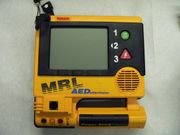Use of Automated External Defibrillators
An automated external defibrillator is used in cases of life threatening cardiac arrhythmias, which may lead, or have lead to cardiac arrest. The rhythms the device will recognise is usually limited to:
Ventricular fibrillation (shortened to VF or V-Fib)
Pulseless Ventricular tachycardia (shortened to VT or V-Tach)
AEDs (and all other defibrillators) are not designed to shock asystole or 'flat line' patterns, as this will not have a positive clinical outcome. The asystolic patient only has a chance of survival if, through a combination of CPR and cardiac stimulant drugs, one of the shockable rhythms can be established.
In each of the two types of shockable cardiac arrhythmia, the heart is in activity (possibly even beating), yet in an unusual pattern, which can be life-threatening if left uncorrected. In ventricular fibrillation, the electrical activity of the heart becomes chaotic, preventing the ventricle from effectively pumping blood. In ventricular tachycardia, the heart beats too fast to effectively pump blood. Frequently, ventricular tachycardia leads to ventricular fibrillation. The fibrillation in the heart decreases over time, and will eventually reach Asystole, with an absence of any rhythm.
Uncorrected, these cardiac conditions rapidly lead to irreversible brain damage and death. For every minute that a person in cardiac arrest goes without being successfully treated (by defibrillation), the chance of survival decreases by 10 percent.
AED's are designed to be used by laypersons, who ideally should have received specialist training. They are usually limited in their interventions to delivering high joule shocks for VF and VT. This is in contrast to more sophisticated manual and semi-automatic defibrillators used by health professionals, which can act as a pacemaker if the heart rate is too slow (bradycardia) and perform other functions which require a skilled operator, able to read electrocardiograms.
Abonohu te:
Posto komente (Atom)

Nuk ka komente:
Posto një koment